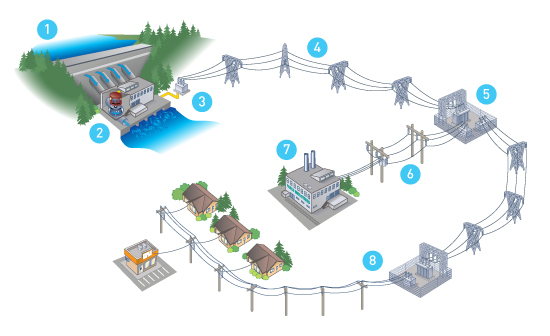Hydroelectric generators
Hydroelectric generators harness water’s energy and converts the energy into electricity. The dam holds back the water creating a large reservoir. The gates on the dam opens and the water gets pulled in through the pen stock which is a pipeline that leads to the turbine. As it flows through the pipe, the water then builds up pressure. Water strikes the blades of a turbine and that’s what makes it turn. The turbine is attached to a generator so as the blades turn, the magnets inside the generator turn as well. The big magnets produce alternating current by having them pass copper coils which makes the electrons more. The transformer takes the alternating current and transforms it into high-voltage current. The used water that went through the entire cycle now goes through the pipelines and returns back to the river downstream. The stored energy, which is the water stored in the reservoir, has its gate open for the used water to go through the pen stock and then to become kinetic energy.
Hydro Electric Generation System
Pros:
Hydroelectric is renewable, you can use it as much as you want but you can’t use it up and continues to have a constant water cycle that goes around the earth. It may be expensive when you must pay for the power plants but it’s not very expensive to pay for workers to take care of them because it can be controlled by itself. It’s also very echo-friendly as it does not cause pollution or to not use gas that can destroy the environment such as the animals and plants. It’s a lot safer because it uses water and it’s reliable because there are very little fluctuations of electric power being used.
Cons:
Hydroelectric generators can still have negative effects in the environment such as killing the fish by changing the sea level. So there may be small risks of floods but not extreme. It is also very expensive to pay for the power plants and plus the employees to take care of them.
Thermal generator
Thermal generators is a device that converts heat to electrical energy. They can be used in power plants to convert waste heat into electrical power. Thermal power plants usually use coal, and nuclear power plants. A steam rotates from high pressure as well as high temperature and the rotation is transferred to a generator which produces electricity. As it rotates, it loses energy which results in low pressure and low temperature steam in the turbine. To bring the low pressure back to its original state so that it can produce electrical continuously, a condenser is used to protect from heat surroundings which converts into steam. When exiting from the condenser fluid is in liquid state, so it’s gone back to its original pressure.
Pros:
Fuels are easy to find because it’s under the earth’s crust and can be transported easily from one place to another. It’s less expensive than hydroelectric generators. It produces lots of energy and there is many areas and locations for thermal generators.
Cons:
It’s non-renewable and causes pollution in the air because it uses gas which effects the outside environment and the animals that live out in the wild. It’s also not reliable because the fossil fuels are very expensive and hazardous sources of energy.
Transmission Process
Electricity is made at a power plant by giant generators and the step-up transformers increase the voltage before long distance transport. The electrical energy is then sent through high-voltage transmission lines that stretch across the country. It reaches a substation, where voltage is lowered so it can travel through smaller power lines. When it travels through distribution lines to your complex or neighbourhood, the step-down transformers reduce the voltage of the power lines. As it connects to your house through the service drop, it then passes through a meter. The electricity goes to the service panel in your basement or garage, where the breakers, fuses protect the wires that protects your house from being overloaded. It then travels through wires that are inside your walls, then to the outlets and finally to the switches that are all over your house.

My Opinion
In my opinion, hydroelectric generators are better than thermal generators. One of the reasons is because hydroelectric generators uses water so it’s a lot safer than thermal generators which causes pollution as it is very hazardous for the environment. It’s also renewable so you can use it up and it won’t run out and is reliable because there are very little fluctuations of electric power being used. With thermal generator, you cannot rely on them because they are too expensive and they are hazardous source of energy which can effect animals and the environment. With hydroelectric generators, it may be expensive for the plants but not for the maintenance because we don’t need to have lots of workers and they usually cost very little to pay for a couple of workers. Thermal generators on the other hand needs lots of oil and gas which is very expensive and may harm the outside environment. One of the most useful things about hydroelectric generators is that it’s very flexible, so adjusting the water flow is very easy and output of electricity is pretty simple, whereas thermal generators need excessive amounts of water for thermal power plants as well as a longer duration before it supplies generated power to the grid. In conclusion, I think hydroelectric power is echo friendly unlike thermal generator because it doesn’t release pollution and is a lot more reliable when needed.
Here is my summary of both Hydroelectric generation and Thermal generation.

